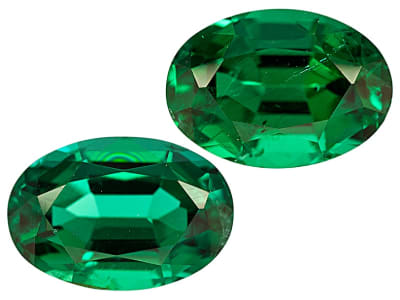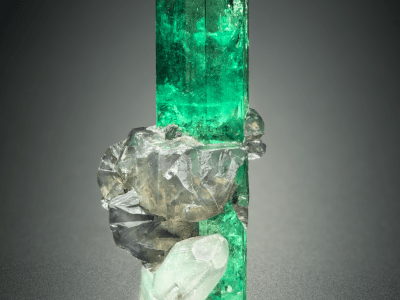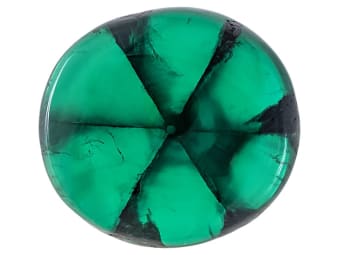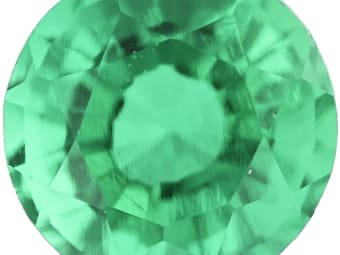Emerald is a beryllium aluminum silicate that owes its color to trace amounts of chromium or vanadium (or both) and, sometimes iron. Stones must have sufficient tone and saturation to be considered emerald. Emerald is the birthstone for May and is considered one of “The Big Three” along with ruby and sapphire. Although attempts at emerald synthesis began in the 1880’s, it was not until the 1930s that a synthetic emerald would be produced in a quality and quantity high enough to be commercially marketable.
General Information
Tolerance:(+0.017/-0.017)
LWUV: Inert to strong orangy red to red
Emerald Colors
-
 Green
Green -
 Green
Green -
 Green
Green -
 Green
Green
Emerald Spectra
We acknowledge the significant scientific contributions of John S Harris, FGA to the study of gemstone spectra and with deep appreciation to him, acknowledges the use of his images and related notes about gemstones and their spectra in the educational materials on this website.
Countries of Origin
Tanzania, United Republic Of; Afghanistan; Russian Federation; Cambodia; Czechia; United States of America; Egypt; Somalia; Madagascar; Kazakhstan; Thailand; Portugal; Austria; Mozambique; Pakistan; Unknown; China; Brazil; Bulgaria; Chile; France; Nigeria; Colombia; Argentina; Romania; Sri Lanka; Rwanda; Ukraine; Zambia; Switzerland; Bolivia (Plurinational State of); India; Spain; Canada; Norway; Namibia; Italy; Mexico; South Africa; Zimbabwe; Australia; Peru; Ethiopia; Germany; Greenland
History
Emerald is the stone that sets the standard by which all green gemstones are measured. The most-famous member of the beryl family, emerald is prized for its variety of greens, often with secondary blue or yellow hues. From deep, rich greens to the palest, springtime pastels, emerald has the perfect color for the green-lover in you. Emeralds get their green from chromium, vanadium, or both. There are other elements that color beryl green, but only those colored by chromium and vanadium are classified as emeralds. In his epic work, Natural History, the Roman historian Pliny the Elder stated of emeralds, "The sight of no other color is more agreeable... because nothing greens greener."
Care
Emeralds are also known for their jardins, French for "gardens" - inclusions intrinsic to each stone and which make every stone unique. Almost all emeralds are oiled. Treat your emerald like the special stone it is - no harsh chemicals, steam, or sonic cleaning. Warm sudsy water will keep it looking its best.
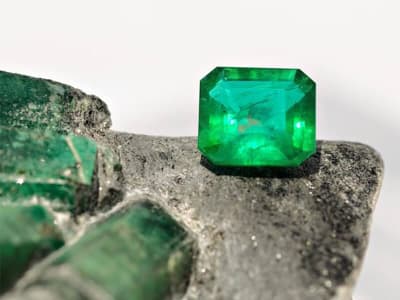
More About Emerald
To the ancient Romans, emerald symbolized the reproductive forces of nature. To the early Christians, emerald represented resurrection. No stone with the glory of color that is emerald could be thought to be less than magical! According to Marbode, writing in the 11th century, "emerald improves memory, makes its owner eloquent and persuasive, and brings him joy." We can't confirm eloquence or persuasion... but we can certainly affirm joy!
Pattern
Trapiche
Trapiche emeralds hail exclusively from the emerald mines in the Boyac region of Colombia, and are so named because their patterns resemble the spoked wheels of the heavy gear locals use to grind sugar cane. Extremely limited in supply, trapiche emeralds are perhaps the rarest of all "pattern" gemstones. Their six distinct "spokes" are caused by the presence of the mineral inclusion lutite. As the hexagonal emerald crystal grew, it pushed the lutite towards the center of the crystal and then radiated out in the six directions of the emerald crystal. A truly remarkable feat, compliments of Mother Nature!
LWUV: Inert
Creation Method
Lab Created Overgrowth Hydrothermal
One of the most popular methods for creating emerald is the hydrothermal process, which uses heat and pressure to imitate natural conditions deep in the earth that formed natural gems. Nutrients are dissolved in a water solution with synthetic crystals forming as the solution cools. Synthetic emeralds offer you the best of both worlds. You get the beauty of a beloved, rare gemstone, but at a budget-friendly price!
LWUV: Moderate to strong red in the synthetic layer
Hydrothermal
Hydrothermally grown synthetic emeralds crystallize slowly out of a solution (a mix of water and dissolved elements) that has been exposed to heat and pressure similar to the conditions on Earth under which the natural gem mineral grows. Synthetic gems have the same chemical, optical, and physical properties of their natural counterparts, but are a more cost-effective alternative to a natural gem.
Tolerance:(+0.007/-0.002)
LWUV: Variable
Sandwich Hydrothermal
Synthetic refers to a man-made material with a natural counterpart. The synthetic crystal replicates the chemical, optical and physical properties of the natural crystal with little or no variation. One of the most popular methods for creating synthetic emerald is the hydrothermal process, which uses heat and pressure to imitate natural conditions deep in the earth that formed natural gems. Nutrients are dissolved in a water solution with synthetic crystals forming as the solution cools. Synthetic emeralds offer you the best of both worlds. You get the beauty of a beloved, rare gemstone, but at a budget-friendly price!
LWUV: Moderate to strong red
Flux Growth
One method of synthesizing emeralds is called flux growth. During the flux growth process, flux, a substance that reduces the melting point of surrounding material, is combined in a metal-lined crucible with the elements that make up emerald. The crucible is heated until its contents are liquid and then it is allowed to cool very slowly. As cooling continues, the gem mineral crystallizes from the solution. Flux grown synthetic gems can take up to a year to grow to a facetable size, but the exceptional clarity of these gems is well worth the wait! Synthetic gems have the same chemical, optical, and physical properties of their natural counterparts, but are a more cost-effective alternative to a natural gem.
Tolerance:(+/-0.003)
LWUV: Variable
Enhancement
Fractured-Filled
Fracture filling is the filling of surface-breaking cavities or fissures with highly refractive colorless glass. This process may improve the appearance, durability and/or weight of the emerald.
LWUV: Variable
